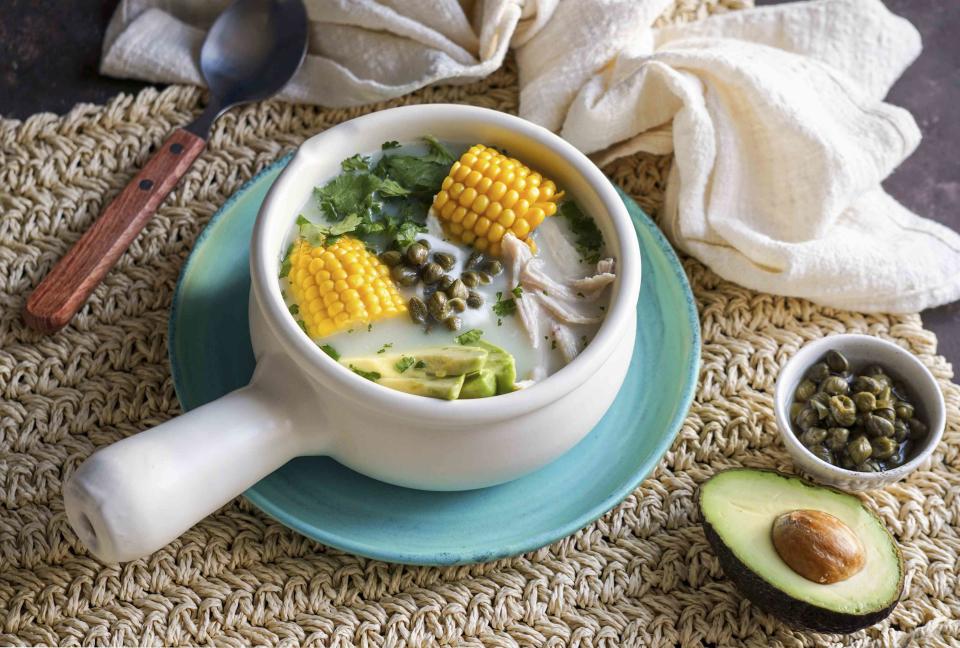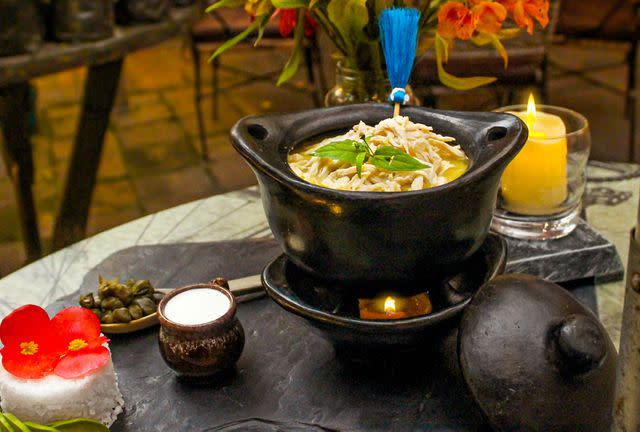Bogotá’s Signature Soup Packs in 3 Kinds of Potatoes
Here's how ajiaco became the signature dish of Colombia's capital — and where to taste it.

Bogdanova, Julia / Getty Images
“You have to slice the potatoes thinly,” said Jack Díaz, director of La Escuela Taller de Bogotá cooking school, as his colleague Mariana demonstrated on the cutting board. He was addressing our class of a dozen students gathered in a colonial house in downtown to learn how to make ajiaco, the hearty, aromatic soup of chicken, potatoes, and corn that’s practically synonymous with Bogotá cuisine.
No dish transports me back to my childhood in the Colombian capital as much as this traditional Bogotá staple. On many Sundays, my family would gather for a midday meal that often featured this beloved comfort food. I remember how the aroma of the herbs — cilantro and guasca — perfumed the air at home as the soup simmered in the pot, which signaled leisurely family time around the dining table. Extended families across the city still gather over ajiaco for Sunday dinner. Since I never learned to make it back then, this cooking class was my attempt to correct that deficiency.
Potatoes are ajiaco’s undisputed stars, Díaz explained. No surprise, because Colombia grows more than 800 varieties. In class, we used the three classic kinds for ajiaco: small yellow criollas, purple-skinned sabaneras, and large white pastusas, native to Colombia. The three varieties, all peeled, mostly broke down in the chicken broth to form a thick, creamy texture and unique flavor combination. We then added shredded precooked chicken breast, cilantro, and big chunks of large-kernel corn on the cob, and seasoned with salt and pepper. Cooked until thick and fragrant, the buttery soup was finished with the distinctive earthy flavor of guasca, an Andean herb also known as “gallant soldier.” Without the guasca leaves, this potato-chicken soup just isn’t an authentic ajiaco santafereño, which refers to the formal name of the city, Santa Fe de Bogotá.
Related: 12 Potato Soup Recipes With Broccoli, Cheddar, Dashi, and More
Although there are many ways of serving ajiaco, it’s traditionally garnished with sliced avocado, capers, and cream — and these days, with white rice — which are stirred into the mixture for even more texture and flavor. After we completed our slicing, dicing, and simmering, we sat down to feast on this quintessential Bogotá meal by liberally enhancing it with the garnishes. Still, preferences vary. Some people place a small piece of the avocado onto the spoon, then add some of the soup to create a tasty mouthful. But I prefer to break it into chunks and mix it right into the soup.
Ajiaco has evolved over the years. When I was growing up in the city, rice was never added, the chicken was served separately still on the bone and the corn was always eaten straight from the cob, not scraped off into the soup as is popular today — changes that seem heretical to me now.
Its origin is just as controversial. Also popular in Peru and Cuba, which both claim ajiaco as their own, it undoubtedly goes back to pre-Columbian times (before Columbus arrived in North America). In fact, it may have originated with the Taíno Indigenous peoples of Cuba before it showed up elsewhere. Documented as part of the Cuban diet as early as the 16th century when it was prepared in clay pots over a wood fire, it probably derived its name from the Taíno word for chili pepper, axí, or ají in Spanish. Unlike Colombians, Cubans and Peruvians still use peppers in their ajiaco today, which they prepare very differently from the Colombian version.
In Colombia, colonial records reference the Muisca (Chibcha) Indigenous people of the Bogotá highlands eating a soup made of potatoes, corn, onion, and hot pepper. Back then, they ate it with a wooden spoon and served it in totumas, or gourd vessels. Over time, the Indigenous heritage blended with ingredients brought from Spain, such as capers, chicken, and cream, to produce the savory dish we know now — a signature amalgam of national history, identity, and culinary traditions.
Today, the soul-warming soup, so appropriate for Bogotá’s chilly Andean climate, is celebrated in an annual weeklong competition among restaurants, markets, and other cooking venues called Días de Ajiaco Santafereño, which started in 2014. Turns out that my cooking school, La Escuela Taller, won first place in the traditional category in 2016.
Many restaurants that serve comida típica, or traditional food, in and around Bogotá feature ajiaco on their menus — from humble mom-and-pop eateries to fine-dining establishments. There’s nothing better on a cold Bogotá day than this filling meal in a pot. If you’re planning a visit, here are some great places to try an authentic ajiaco.

Santa Fe Restaurante
Santa Fé Café & Restaurante
Winner of the 2018 contest for best traditional ajiaco, Santa Fé Café & Restaurante is proud of its signature dish, served for almost 25 years. Located in the city’s La Macarena barrio, it’s as intimate as a French bistro, where the individual rooms and patio exude a vintage bohemian vibe with eclectic artwork and colorful décor.
La Puerta Falsa
Tucked into the historic La Candelaria neighborhood a block from the Plaza Bolívar, this tiny hole-in-the-wall is one of the city’s oldest restaurants, dating to 1816. Based in a colonial home across the street from a false door of the Cathedral (ergo its name), La Puerta Falsa hasn’t changed much over the years. It still serves Bogotá classics including coconut sweets, traditional Colombian hot chocolate with cheese and bread, and of course, steaming bowls of ajiaco. Patrons sit cheek by jowl at the few tables, so be prepared to wait your turn to be seated.
Casa Vieja
With its signature ajiaco leading the way on the menu, Casa Vieja takes pride in offering “authentic Colombian cuisine” from around the country since 1964. Diners sit in a Belle Epoque-style venue amid elegant colonial antiques, paintings, and white tablecloths right in the heart of the capital.
Restaurante Las Margaritas
The rustic Restaurante Las Margaritas dishes up authentic “Santa Fe food” at one of the most traditional restaurants in Bogotá. Founded in 1902 by Margarita Ángel in the Chapinero neighborhood and run by five generations of her family, the iconic restaurant is part of the city’s gastronomic history. Known for its signature corn empanadas and ajiaco santafereño served in glazed ceramic bowls, it’s only open Saturdays, Sundays, and holidays.
For more Food & Wine news, make sure to sign up for our newsletter!
Read the original article on Food & Wine.


